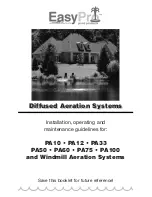
13
Analog Control Troubleshooting —
The following
troubleshooting procedure is directed towards single duct cool-
ing applications. The same concepts can be applied to other
configurations.
CONTROLLER
1. Verify 24 vac at terminals “~” (phase) and “-” (ground).
Tolerance can be –15% to +20% (20.4 to 28.8 vac).
2. Verify 16 vdc at terminals “(16 VDC)” and “(-)”.
a.
Tolerance is 15.0 to 17.0 vdc power supply to
thermostat.
b.
If not correct, disconnect thermostat and recheck.
If still incorrect, replace CSP controller.
3. Check Requested Flow voltage on terminal “IN” and
“-”.
a.
Use chart on page 12 to correlate into cubic feet
per minute (cfm).
b.
If reading is not what is desired, see System Cali-
bration of the Linear Averaging Flow Probe sec-
tion to adjust thermostat.
4. Check Actual Flow voltage on terminal “OUT” and “-”
for 0 to 10 vdc.
Use chart on page 12, Fig. 14 to correlate into cfm.
5. Check box movement, damper rotation, etc.
a.
Review Requested Flow and Actual Flow above
to determine if unit should be satisfied (within
50 fpm) or driving open or closed.
b.
If damper is not moving, verify damper is not
stuck or at end of travel. Check rotation jumpers
for proper position.
c.
Change “Requested Flow” to make unit drive
opposite direction. This can be accomplished by
moving the set point sliders or 1) and 2) below.
1) To manually open the box, remove wiring
from terminal “IN” and jumper terminal “IN”
to terminal “16VDC”. This will tell unit to
control at 3300 fpm/full airflow, and the green
LED should turn on (and the box should drive
open).
2) To manually close the box, remove wiring
from terminal “IN”, jumper and “IN” terminal
to “-” terminal. This will tell unit to control at
zero fpm/no airflow, and the red LED should
be on (and the box should drive closed).
NOTE: When using the same transformer for more than one
control, the phase and ground must be consistent with each
device.
ComfortID™ CONTROLS
Install
Sensors
and
Make
Field
Wiring
Connections
GENERAL — All field wiring must comply with National
Electrical Code and local requirements. Refer to Tables 6-9 for
electrical and wiring specifications.
Wire the control as shown on the control package diagram
for the specific installation. Control wiring diagrams can be
found inside the control box.
If the 35E unit is equipped with electric heat, only power to
the electric heater must be supplied; no additional power
source is required for the control. If the unit does not have an
electric heater or the control transformer option, a field-
supplied dedicated 24-vac/Class II power source must be in-
stalled and wired to the zone controller, to terminals 1 and 2 of
connector J1. Refer to unit wire label diagram for minimum
size (VA) and grounding requirements for each unit.
SUPPLY-AIR TEMPERATURE (SAT) SENSOR INSTAL-
LATION — On terminals with heat, the SAT sensor is provid-
ed. The sensor is factory wired to the controller and shipped in
the control box. The SAT must be field-installed in the duct
downstream from the air terminal. The SAT sensor part num-
ber is 33ZCSENSAT. See Table 6 for resistance information.
To install the sensor, proceed as follows:
1. Remove the plug from one of the
7
/
8
-in. openings in the
control box and pass the sensor probe through the hole.
2. Drill or punch a
1
/
2
-in. hole in the duct downstream of
the unit, at a location meeting the requirements shown in
Fig. 15.
3. Using 2 self-drilling screws (supplied), secure the sensor
probe to the duct.
The SAT sensor probe is 6 inches in length. The tip of the
probe must not touch the inside of the duct. Use field-supplied
bushings as spacers when mounting the probe in a duct that is
6 in. or less in diameter.
If the unit is a cooling only unit, the SAT sensor is not pro-
vided and is not required.
If the unit has a multiple outlet attenuator connected directly
at the discharge, install the sensor in the multiple outlet attenua-
tor. See Fig. 15.
For units equipped with electric reheat, locate the sensor as
far downstream as possible. This ensures the sensor will not be
affected by excessive radiant heat from the heater coil. Install
the sensor a minimum of 2 ft downstream of the coil for units
with hot water heat.
Perform the following steps if state or local code requires
the use of conduit, or if your installation requires a cable length
of more than 8 ft:
1. Disconnect the sensor cable from the ComfortID zone
controller, at the terminals labeled SAT and GND.
2. Mount the sensor to the duct (see steps 2 and 3 above).
3. Mount a field supplied 4 in x 4 in x 20 in. extension box
over the duct sensor.
4. Connect a conduit (
1
/
2
-in. nominal) to the zone controller
enclosure and extension box.
5. Pass the sensor probe through the extension box opening
and into the conduit.
6. Reconnect the sensor leads to the zone controller labeled
SAT and GND.
Never jumper terminal 16 VDC to “-” as this would cause
a short, and possibly damage the power supply.
Disconnect electrical power before wiring inside the con-
troller. Electrical shock, personal injury, or damage to the
zone controller can result.
DO NOT run sensor or relay wires in the same conduit or
raceway with Class 1 service wiring.
DO NOT abrade or nick the outer jacket of cable.
DO NOT pull or draw cable with a force that may harm the
physical or electrical properties.
DO NOT bend a cable through a radius sharper than that
recommended by its manufacturer.
AVOID splices in any control wiring.










































